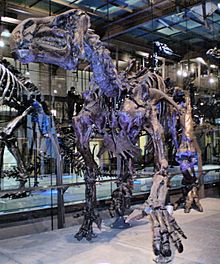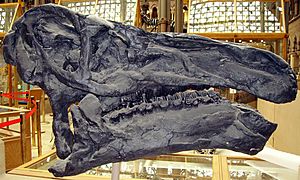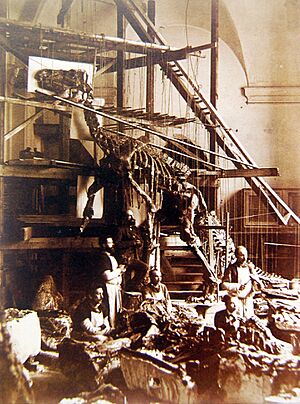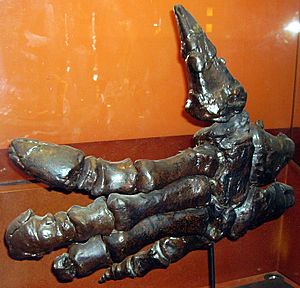Iguanodon facts for kids
Quick facts for kids IguanodonTemporal range: Lower Cretaceous
|
|
|---|---|
 |
|
| Iguanodon mounted in a quadrupedal posture. Brussels | |
| Scientific classification | |
| Kingdom: | |
| Class: | |
| Superorder: | |
| Order: | |
| Suborder: | |
| Infraorder: | |
| Superfamily: |
Cope, 1869
|
| Family: |
Iguanodontidae
Cope, 1869
|
| Genus: |
Iguanodon
|

The Iguanodon is a type of dinosaur that lived during the Lower Cretaceous period. This was about 125 to 126 million years ago. Its fossils have been found in Europe, North America, Africa, and Asia.
An English geologist named Gideon Mantell discovered Iguanodon in 1822. He officially described it three years later. It was only the second dinosaur ever to be formally named. The first was Megalosaurus.
Iguanodon was a large, strong plant-eater, also known as a herbivore. Some scientists think it might be related to the duck-billed hadrosaurs. Scientists are still studying its family tree. They often find new species or move old ones to different groups.
Our understanding of Iguanodon has changed a lot over time. New information comes from studying its fossils. Researchers make educated guesses about how it lived. This includes how it ate, moved, and behaved in groups. As one of the first dinosaurs known to science, Iguanodon is quite famous. How artists draw it has changed as we learn more about its bones.
Contents
What Kinds of Iguanodon Are There?
Scientists have officially recognized at least two types, or species, of Iguanodon:
- I. bernissartensis was named by George Albert Boulenger in 1881. This is the main species for the Iguanodon group. Many skeletons of this species were found in 1878. They were in coal mines in Bernissart, Belgium. A total of 36 adult skeletons were dug up there. This was the biggest discovery of this species. These dinosaurs were very large and powerful.
- I. galvensis was described in 2015. This species is known from adult and young dinosaur remains. They were found in Teruel, Spain. These fossils are about 126 million years old.
How Iguanodon Moved and Stood
The front legs of Iguanodon were shorter than its back legs. Because of this, Mantell thought it walked on two legs. However, another scientist, Richard Owen, believed it walked on all four legs. It turns out, Iguanodon probably did both!
It likely walked slowly on all fours. But when it needed to move faster, it would run on its two back legs. Its body would have been more horizontal, not standing straight up. Its tail would have been held off the ground. This was possible because of its strong, bony ligaments in the tail. You can clearly see these on a skeleton.
If a predator attacked, Iguanodon could stand on its hind legs. It would use its strong front arms and sharp, dagger-like thumbs to defend itself.
What Iguanodon Ate
Iguanodon had teeth that were close together and good for grinding. This shows it was a browser, meaning it ate plants like leaves and twigs. Scientists believe that, like most other ornithischian dinosaurs, Iguanodon had some kind of cheek-like structure. This would have helped keep food inside its mouth while it chewed.
Images for kids
-
Restoration of I. bernissartensis (second from left) among other ornithopods
-
I. bernissartensis from the Isle of Wight, Dinosaur Isle Museum
-
Skeletal restoration of I. bernissartensis by O.C. Marsh, 1896
-
Mounted skeleton of Mantellisaurus atherfieldensis, Natural History Museum, London
-
Restoration of Hypselospinus fittoni
-
Mounted skeleton of Cumnoria prestwichii, Oxford University Museum of Natural History
-
Iguanodon appearing in Arthur Conan Doyle's The Lost World
See also
 In Spanish: Iguanodon para niños
In Spanish: Iguanodon para niños





















